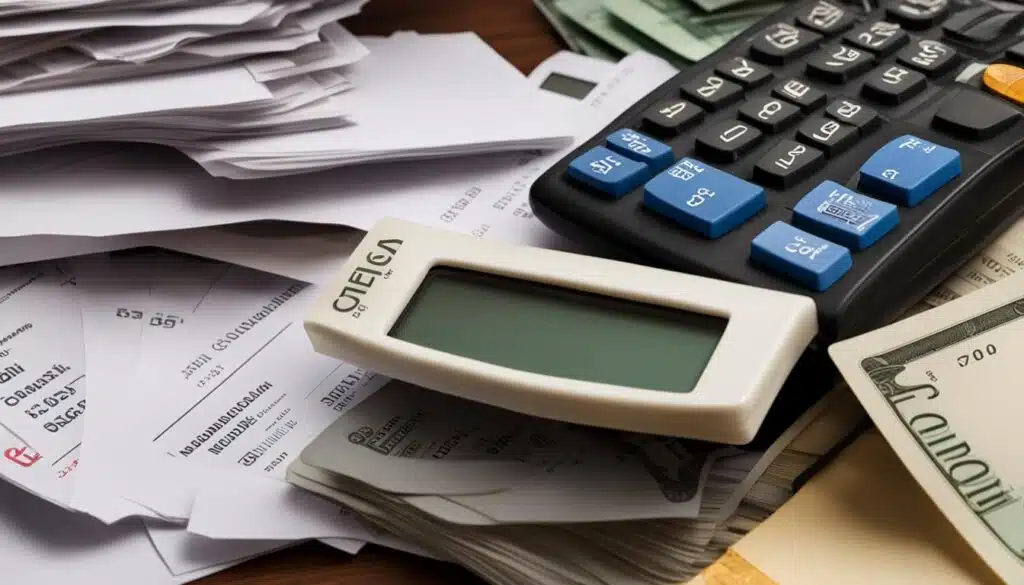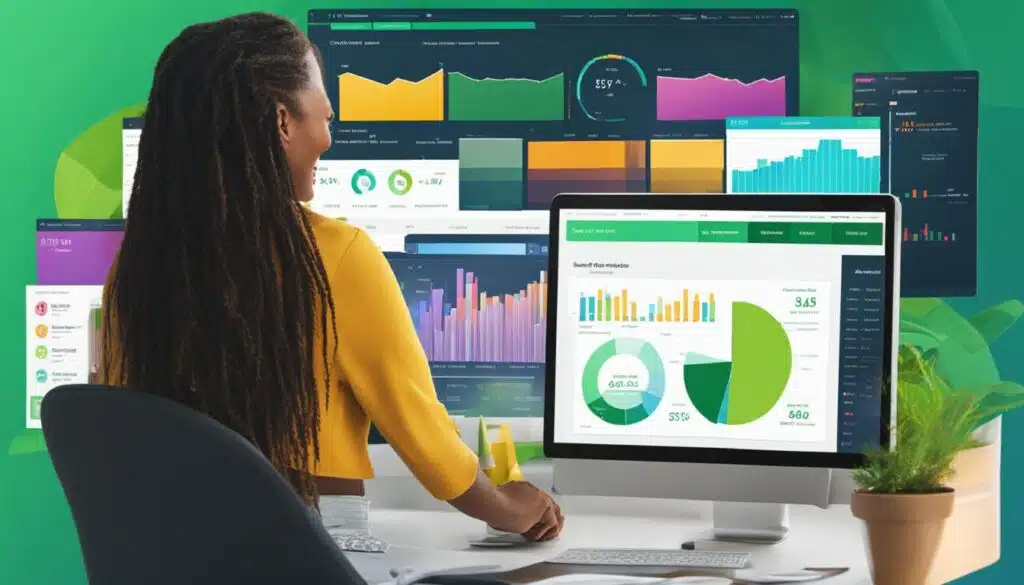Many people have financial goals, whether it’s saving for a house or car, becoming debt-free, or building an emergency fund. Money Dashboard is a budgeting app that can help you reach these goals. It provides tools for setting specific savings goals, creating timelines, and tracking your progress. With Money Dashboard, you can easily manage your personal finances and take control of your money.
Key Takeaways:
- Money Dashboard is a budgeting app that helps you achieve your financial goals.
- Set specific savings goals and create a timeline to track your progress.
- Manage your personal finances effectively with Money Dashboard.
- Utilize the app’s features for budgeting and tracking expenses.
- Stay motivated and make necessary adjustments to your financial plan.
Setting Savings Goals
To achieve your financial goals, it’s important to set specific savings goals. Determine what you’re aiming for, whether it’s a house, a car, or financial independence, and calculate how much you need to save to achieve it. Set a timeline for when you want to reach your goal, and adjust your savings plan accordingly.
Setting savings goals provides you with a clear target to work towards and helps you stay motivated on your financial journey. It allows you to break down larger objectives into smaller, more achievable milestones. By having a well-defined goal and timeline, you can track your progress and ensure you’re on the right track to financial success.
“The only way to achieve financial freedom is by setting savings goals and having a plan to reach them.”
Creating savings goals helps you prioritize your spending and make sure you’re allocating enough money towards your future. Whether you’re saving for a dream holiday, a new business venture, or a comfortable retirement, setting clear goals gives you direction and purpose. It gives you something to strive for and provides a sense of accomplishment when you achieve each milestone along the way.
Creating Specific Savings Goals
When setting savings goals, it’s crucial to be specific. Rather than simply aiming to “save money,” determine the exact amount you want to save and the timeframe in which you want to achieve it. For example, your goal could be to save £10,000 for a down payment on a house within the next two years.
By setting specific goals, you can develop a realistic savings plan tailored to your financial situation. It allows you to calculate how much you need to save each month, factoring in your current income and expenses. This level of detail helps you stay accountable and provides a clear roadmap to follow.
Tracking Your Progress with Money Dashboard
Money Dashboard is an innovative budgeting app that can assist you in achieving your savings goals. It provides a comprehensive overview of your finances, allowing you to track your progress and visualize your savings journey. With its user-friendly interface and powerful tools, Money Dashboard can help you stay on top of your financial goals.
With Money Dashboard’s savings goal feature, you can set specific objectives, enter your target amount and deadline, and watch your progress unfold. The app provides real-time updates, reminding you of your goals and giving you a clear picture of how far you’ve come. With this level of visibility, you can make the necessary adjustments to your savings plan to ensure you stay on track.
Furthermore, Money Dashboard allows you to analyze your spending patterns and identify areas where you can cut back. By creating a budget and tracking your expenses, you can allocate more money towards your savings goals. The app’s insights and reports enable you to make informed decisions and take control of your financial future.
By utilizing Money Dashboard’s features, you can streamline your savings journey, make empowered financial choices, and achieve your desired financial outcomes.
| Benefits of Setting Savings Goals | How Money Dashboard Can Help |
|---|---|
| Provides a clear target to work towards | Offers savings goal feature to set specific objectives |
| Breaks down larger objectives into achievable milestones | Provides real-time updates on progress and deadlines |
| Prioritizes spending and directs resources towards future goals | Allows you to track spending patterns and make informed decisions |
| Increases motivation and sense of accomplishment | Offers insights and reports to stay accountable and empowered |
Also Read :Best Money Transfer Credit Cards Of 2024
Budgeting and Money Management

Budgeting and money management play a crucial role in achieving your financial goals. With the help of Money Dashboard, a leading personal finance app, you can effectively analyze your current spending and identify areas where you can make adjustments. By tracking your income and expenses through the app, you can gain a clear understanding of your financial situation and determine how much money you can allocate towards savings.
Money Dashboard empowers you to take control of your finances and make informed decisions.
Regularly reviewing your savings goals and strategies is key to staying on track and making necessary adjustments along the way. Let’s explore how Money Dashboard can support you in your budgeting and money management journey.
Track Your Spending
Money Dashboard provides a user-friendly interface that allows you to effortlessly track your spending habits. By categorizing your expenses, you can easily identify areas where you might be overspending or where you have the potential to cut down.
“Money Dashboard helps you gain insights into your spending habits, enabling you to make more informed decisions about your money.”
Create a Budget
With Money Dashboard’s budgeting feature, you can set spending limits for different categories and have a comprehensive overview of your budget. This helps you prioritize your expenses and ensure that you’re allocating funds wisely.
“Money Dashboard’s budgeting feature empowers you to make proactive financial decisions and achieve balance in your spending.”
Set Savings Goals
Setting savings goals is a critical step toward achieving financial success. Money Dashboard allows you to set clear savings goals and track your progress as you work towards them. You can assign target amounts and specific timelines, making it easier to stay motivated and on track.
“Money Dashboard enables you to turn your financial dreams into achievable goals, providing the tools you need to succeed.”
Monitor Your Financial Health
By regularly reviewing your financial information on Money Dashboard, you can monitor your financial health and make necessary adjustments. Keep a close eye on your income, expenses, and savings progress to ensure you’re heading in the right direction.
“Money Dashboard serves as your financial compass, guiding you towards improved financial well-being.”
| Benefits of Money Dashboard for Budgeting and Money Management: |
|---|
| You can easily track your spending and identify areas for improvement. |
| Money Dashboard helps you create a realistic and effective budget. |
| You can set savings goals and track your progress towards them. |
| Monitor your financial health and make necessary adjustments. |
Also Read :Money Helper: Your Guide to Financial Wellness
Creating a Financial Plan

A comprehensive financial plan is crucial for achieving long-term financial goals. It allows you to assess your current financial situation and develop strategies to reach your objectives. By considering factors such as income, debt, savings, assets, and investments, you can create a roadmap towards financial success. Planning for retirement and building an emergency fund are also vital components of a robust financial plan.
When creating your financial plan, it’s important to outline your goals, timelines, and specific strategies for achieving them. This will help you stay focused and measure your progress along the way. Whether your long-term financial goal is to retire comfortably or save for a child’s education, a thorough financial plan will provide the guidance and structure you need.
Components of a Financial Plan |
Strategies for Achieving Financial Goals |
|---|---|
|
|
“A goal without a plan is just a wish.” – Antoine de Saint-Exupéry
Creating a financial plan can seem daunting, but with the help of tools like Money Dashboard, you can simplify the process and gain valuable insights into your financial journey. Money Dashboard provides the tools and resources to help you create and implement a personalized financial plan, tracking your progress along the way. By utilizing these tools and following a well-crafted financial plan, you can confidently work towards achieving your long-term financial goals.
With a solid financial plan in place, you’ll be better equipped to make informed decisions, manage your money effectively, and pave the way towards a secure financial future.
Also Read :how does whatsapp make money
Building Wealth through Investments

Building wealth is not solely about saving money. Investing plays a vital role in achieving financial growth and building long-term wealth. Money Dashboard encourages users to consider various investment options to maximize their savings and generate passive income.
By investing in stocks, bonds, or other assets, you can make your money work for you. These investments have the potential to generate returns and increase your wealth over time. Money Dashboard provides valuable resources and guidance to help users understand different investment options and get started with investing, even if they are beginners.
Investing allows you to diversify your financial portfolio and take advantage of opportunities for growth. It is a proactive approach to wealth building, as it enables you to earn passive income and potentially multiply your initial investment.
When considering investments, it’s essential to do thorough research and understand the risks involved. Money Dashboard helps users make informed decisions by providing insights into the performance of various investment options. This empowers users to make choices aligned with their financial goals and risk tolerance.
Investment Options
There are several investment options available, each with its own unique benefits and risks:
- Stocks: Investing in individual company shares provides the opportunity for long-term growth and potential dividends.
- Bonds: Bonds are fixed-income securities that can provide a steady stream of income over time.
- Mutual Funds: Mutual funds allow investors to pool their money with others to invest in a diversified portfolio of stocks, bonds, or other assets.
- Exchange-Traded Funds (ETFs): ETFs are similar to mutual funds but trade on the stock exchange. They offer diversification and flexibility.
- Real Estate: Investing in real estate can provide both rental income and potential appreciation of property value.
Each investment option has its own set of advantages and considerations. It’s important to evaluate your financial goals, risk tolerance, and investment horizon when choosing the most suitable option.
Money Dashboard offers valuable insights and educational resources to help users understand these investment options better. Whether you’re a beginner or an experienced investor, Money Dashboard equips you with the knowledge and tools to make informed investment decisions and accelerate your wealth-building journey.
Remember, investing involves risks, and it’s crucial to consult with financial professionals or advisors before making any investment decisions.
| Investment Option | Potential Returns | Risk Level | Liquidity |
|---|---|---|---|
| Stocks | High potential for returns | High risk | High liquidity |
| Bonds | Steady income | Low to moderate risk | Medium liquidity |
| Mutual Funds | Potential for growth and income | Moderate risk | Medium liquidity |
| ETFs | Potential for growth and income | Moderate risk | High liquidity |
| Real Estate | Rental income and property appreciation | Moderate to high risk | Low liquidity |
Table shows a comparison of different investment options based on their potential returns, risk level, and liquidity.
Also Read: Smart Tips to Buy a Car on Finance Easily
Debt Management

Managing debt is an important aspect of financial planning. Money Dashboard emphasizes the need to prioritize paying down debt and offers strategies for doing so. These strategies may include debt consolidation, balance transfers, or creating a repayment plan. By effectively managing debt, you can free up more money for savings and reach your financial goals faster.
Debt consolidation is a popular method for simplifying multiple debt payments into a single monthly payment. This can make it easier to keep track of your financial obligations and potentially lower your overall interest rates. It allows you to combine your debts into one loan, often with a lower interest rate, resulting in lower monthly payments and the convenience of a single payment. Money Dashboard can help you organize your debts and assess whether debt consolidation is a viable option for you.
“Debt consolidation can simplify your financial life and potentially save you money in interest payments.”
Another strategy for paying down debt is through balance transfers. This involves transferring high-interest debt from one credit card to another with a lower interest rate or even 0% introductory APR. By taking advantage of balance transfer offers, you can reduce the amount of interest you pay and make progress towards becoming debt-free. Money Dashboard provides insights into your credit card balances and allows you to assess whether balance transfers could benefit you.
“Balance transfers can be a smart way to tackle high-interest debt and accelerate your journey towards financial freedom.”
Straight from the Experts
“By prioritizing debt repayment and utilizing strategies like debt consolidation and balance transfers, you can regain control of your finances and work towards a debt-free future. Money Dashboard can assist you in visualizing your debt and implementing an effective debt management plan.”
– Financial Advisor, Sarah Collins
Creating a repayment plan is another key part of debt management. Money Dashboard enables you to set up customized repayment schedules, allocate funds towards debt reduction, and track your progress. By sticking to a structured plan, you can systematically pay off your debts and ultimately achieve financial freedom.
Incorporating debt management into your financial plan is essential for reaching your long-term goals. By using Money Dashboard to consolidate debt, explore balance transfer options, and create a repayment plan, you can effectively reduce your debt burden and free up more funds for saving and investing.
| Debt Management Strategies | Benefits |
|---|---|
| Debt Consolidation | Simplifies payments, potentially lowers interest rates, and streamlines debt management. |
| Balance Transfers | Reduces interest payments and accelerates debt repayment. |
| Repayment Plans | Provides structure and helps you stay on track with debt reduction goals. |
Flexibility and Adjustments in Financial Planning

When it comes to financial planning, flexibility is key. Life is full of changes and unexpected events, and your financial plan should be able to adapt to these circumstances. Money Dashboard understands the importance of staying agile in your financial journey and encourages users to regularly review and adjust their plans as necessary.
One of the crucial aspects of flexibility in financial planning is taking into account changes in income. Whether you receive a pay raise, switch jobs, or experience fluctuations in freelance income, it’s essential to reassess your budget and savings goals accordingly. By adjusting your financial plan to accommodate these changes, you can ensure that your budget remains realistic and achievable.
Similarly, expenses can change over time. From unexpected bills to new financial commitments, there are various factors that can impact your spending. By regularly reviewing your expenses and making necessary adjustments, you can ensure that your financial plan remains aligned with your current lifestyle and priorities.
Goals are not set in stone, and they can evolve as you progress on your financial journey. As you achieve certain milestones or experience significant life events, it’s important to reassess your goals and adjust them accordingly. Whether you decide to save for a new goal, reallocate funds, or pivot your financial strategy, being adaptable and open to reevaluating your objectives can keep you on track towards long-term financial success.
Money Dashboard provides the tools and resources you need to make these adjustments smoothly. With its intuitive interface and comprehensive financial insights, you can easily track your progress, review your goals, and make informed decisions based on your evolving circumstances. Regularly reviewing your financial plan and making necessary revisions with the help of Money Dashboard will ensure that your finances remain on the right track.
Benefits of Flexibility and Adjustments in Financial Planning
By embracing flexibility and making adjustments in your financial planning, you can:
- Successfully navigate life changes and unexpected events
- Ensure your budget and savings goals remain realistic and achievable
- Adapt your financial plan to evolving income and expenses
- Stay on track towards your financial goals even as they evolve
- Maintain a proactive approach to your financial well-being
Remember, financial planning is not a one-time task but an ongoing process. By regularly reviewing and adjusting your plan, you can stay flexible, adaptable, and in control of your financial future.
| Key Benefits | Why It Matters |
|---|---|
| Accommodates life changes | Life is unpredictable, and your financial plan should be able to adapt to unexpected events and new challenges. |
| Optimizes budget and savings goals | Regular adjustments ensure that your plan remains realistic and achievable, enhancing your overall financial well-being. |
| Aligns with income and expenses | Adjusting your plan to changes in income and expenses helps you maintain financial stability and make informed financial decisions. |
| Facilitates evolving goals | By actively revisiting and adjusting your goals, you can stay motivated and ensure your plan remains relevant and rewarding. |
Stay in control of your financial future through flexibility and adjustments. With Money Dashboard by your side, you can adapt to the twists and turns of life while maintaining progress towards your financial goals.
Implementing and Tracking Your Financial Plan

Creating a financial plan is just the beginning of your journey towards financial success. To truly achieve your goals, you need to take action and implement your plan effectively. Money Dashboard offers a range of tools and features that can help you put your financial plan into practice and track your progress along the way. By leveraging these resources, you can stay on top of your finances and make informed decisions to achieve your desired outcomes.
One of the first steps in implementing your financial plan is to set up accounts and link them to Money Dashboard. This allows you to have a comprehensive view of your financial situation in one place. By aggregating all your accounts, including bank accounts, credit cards, loans, and investments, you can get a clear picture of your income and expenses.
Another useful feature provided by Money Dashboard is the ability to automate deposits and payments. By setting up automated transfers, you can ensure that a portion of your income goes directly towards your savings goals or debt repayments. This eliminates the need for manual transfers and minimizes the risk of forgetting to allocate funds towards your financial priorities.
Tracking your progress is a vital part of implementing your financial plan. Money Dashboard allows you to effortlessly monitor your financial goals and track how your balances change over time. With visual representations and easy-to-understand graphs, you can visualize your progress and identify areas for improvement. Regularly reviewing your progress keeps you motivated and accountable, helping you stay on track towards achieving your goals.
Here’s an example of how Money Dashboard can help you track your progress:
| Category | Savings Goal | Current Balance | Target Date | Percentage Progress |
|---|---|---|---|---|
| Emergency Fund | £10,000 | £5,000 | 31/12/2022 | 50% |
| Retirement Fund | £500,000 | £250,000 | 31/12/2040 | 50% |
| Travel Fund | £5,000 | £3,000 | 31/12/2022 | 60% |
In this example, you can clearly see the savings goals, current balances, target dates, and percentage progress for each category. This provides a visual representation of your progress and helps you assess how well you’re tracking towards your goals.
By regularly reviewing your financial plan and tracking your progress through Money Dashboard, you can make informed decisions and adjust your strategy as needed. Whether it’s increasing your savings contributions, adjusting your investment allocations, or reassessing your spending habits, staying proactive in managing your finances is key to achieving long-term success.
Implementing your financial plan and tracking your progress may require discipline and dedication, but with the help of Money Dashboard, you can stay on top of your finances and make significant strides towards your financial goals.
Key Takeaways
- Implementing your financial plan is crucial for achieving your goals.
- Set up accounts and automate deposits and payments to streamline your financial management.
- Track your progress through Money Dashboard’s visual representations and graphs.
- Regularly review and adjust your financial plan as needed to stay on track towards your goals.
Utilizing Money Dashboard’s Features

Money Dashboard provides a range of features that can help you effectively manage your finances and make informed decisions about your money. Two essential features worth highlighting are the budget planner and the balance history.
Budget Planner
The budget planner feature offered by Money Dashboard allows you to set spending limits and track your expenses with ease. By creating a budget, you can allocate your money towards different categories, such as groceries, transportation, entertainment, and more. This feature provides a comprehensive overview of your spending habits, helping you identify areas where you may be overspending.
“The budget planner in Money Dashboard has been a game-changer for me. It’s so easy to set spending limits for different categories and monitor my expenses. I’ve become more mindful of my spending habits and managed to cut down on unnecessary expenses.”
– Emma Wilson, Money Dashboard User
Whether you want to save more money, reduce debt, or achieve other financial goals, the budget planner can be your ally in creating a realistic and effective budget that aligns with your goals and ambitions.
Balance History
The balance history feature in Money Dashboard provides you with a detailed breakdown of your account balances over time. This invaluable resource enables you to analyze your financial progress, understand how your balances fluctuate, and gain insights into your financial habits and patterns. By reviewing your balance history, you can identify trends and make adjustments to your financial strategies as needed.
Furthermore, the balance history feature can be a useful tool for spotting irregularities or unauthorized transactions that may affect your financial well-being. By staying vigilant and regularly reviewing your balance history, you can promptly address any suspicious activities and maintain the security of your accounts.
“Having access to my balance history in Money Dashboard has given me peace of mind. I can quickly spot any discrepancies and take action to resolve them. It’s an excellent feature that allows me to stay in control of my finances.”
– Daniel Thompson, Money Dashboard User
Utilizing the balance history feature empowers you to take charge of your financial journey, enabling you to make proactive decisions and stay on top of your overall financial health.
By utilizing Money Dashboard’s budget planner and balance history features, you can gain valuable insights into your financial habits, effectively manage your finances, and make informed decisions about your money. These features are designed to support you along your financial journey, helping you achieve your goals and paving the way to financial freedom.
How to delete your Money Dashboard account
Alternative budgeting apps to Money Dashboard
5 steps to getting the most out of Money Dashboard Neon
Broken since open banking Santander Credit
Money Dashboard Review: What We Really Think
Get the best of our money saving content every Thursday, straight to your inbox
Map shows lowest paid boroughs in London amid cost of living crisis
Money Dashboard Alternatives UK
Conclusion
Money Dashboard offers a powerful solution for managing your money, tracking expenses, and achieving your financial goals. With its user-friendly budgeting features, personalized financial planning tools, and comprehensive insights, Money Dashboard empowers you to take control of your finances and make informed decisions.
Whether you’re saving for a specific goal, such as a new home or a dream vacation, or aiming for long-term financial security, Money Dashboard can help you succeed. By providing a clear overview of your income, expenses, and savings, Money Dashboard enables you to stay on track and make meaningful progress towards your goals.
By utilizing Money Dashboard’s benefits of budgeting, financial planning, and expense tracking, you can effectively manage your money and align your spending with your financial aspirations. Start using Money Dashboard today and take a step towards achieving financial freedom.
FAQs
Q: What is Money Dashboard?
A: Money Dashboard is a budgeting app that helps you manage all your accounts in one place through open banking.
Q: How does Money Dashboard work?
A: Money Dashboard works by allowing you to connect all your bank accounts to the app, enabling you to see where your money is going and helping you budget your money effectively.
Q: Is Money Dashboard a reliable financial management app?
A: Yes, Money Dashboard is considered one of the best personal finance apps in the UK and is regulated by the Financial Conduct Authority.
Q: What are some alternatives to Money Dashboard?
A: Some alternatives to Money Dashboard include Emma app, Snoop, and Neon.
Q: When is Money Dashboard closing?
A: Money Dashboard has announced that it will be closing accounts from 31st October 2023.
Q: How can I delete my Money Dashboard account?
A: To delete your Money Dashboard account, you can follow the instructions provided on the app or website.
Q: What is Neon in relation to Money Dashboard?
A: Neon refers to the mobile app version of Money Dashboard, offering both Neon and Classic versions for users.
Q: Can I snoop on my spending habits with Money Dashboard?
A: Yes, Money Dashboard allows you to track and monitor your spending habits, helping you save money and budget effectively.









